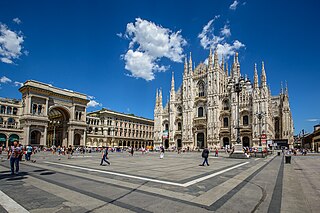
The City of San Marino is the capital city of the Republic of San Marino. It has a population of 4,061. It is on the western slopes of San Marino's highest point, Monte Titano.

Monti is the 1st rione of Rome, identified by the initials R. I, located in Municipio I. The name literally means "mountains" in Italian and comes from the fact that the Esquiline, the Viminal Hills, and parts of the Quirinal and the Caelian Hills belonged to this rione: currently, however, the Esquiline Hill belongs to the rione Esquilino.

Esquilino[eskwiˈliːno] is the 15th rione of Rome, identified by the initials R. XV, and is Located within the Municipio I. It is named after the Esquiline Hill, one of the Seven Hills of Rome.

Castro Pretorio is the 18th rione of Rome (Italy), identified by the initials R. XVIII, and it is located within the Municipio I. The rione takes its name by the ruins of the Castrum Praetorium, the barracks of the Praetorian Guard, included in the Aurelian Walls.

The Towers of Bologna are a group of medieval structures in Bologna, Italy. The two most prominent ones remaining, known as the Two Towers, are a landmark of the city.

The Gruppo Torinese Trasporti (GTT) is a public benefit corporation responsible for public transportation in the provinces of Alessandria, Cuneo, Asti and the Metropolitan City of Turin. It was created in 2003 from the merge of ATM and SATTI, the latter responsible for railway connection in the province of Turin as well as for the Turin metro. GTT is now wholly owned by the Turin City Hall.

Poste San Marino is the company responsible for postal service in San Marino.

The Bologna trolleybus system is part of the public transport network of the city and comune of Bologna, in the region of Emilia-Romagna, northern Italy. While being in operation since 1991, the current system comprises five urban routes: 13, 14, 15, 32 and 33. Additional routes are presently under construction.

The Zone 1 of Milan, since 2016 officially Municipality 1 of Milan, is one of the 9 administrative administrative divisions of Milan, Italy.

Piazza d'Aracoeli is a square of Rome (Italy), placed at the base of the Capitoline Hill, in the Rione X Campitelli.

The Porta Saragozza of Bologna was one of the gates or portals in the medieval walls of this city.

Porta Maggiore, now known as Porta Mazzini, was the main eastern portal of the former medieval walls of the city of Bologna, Italy. It straddles the site in which the Strada Maggiore of Bologna changes name to via Mazzini, immediately west of the intersection with the Viale di Ciconvallazione.
Porta San Vitale, sometimes known as Porta per Ravenna, was an eastern portal of the former outer medieval walls of the city of Bologna, Italy. It is located on a piazza of the same name, immediately west of the intersection of Via San Vitale with the Viale di Ciconvallazione.

The Palazzo della Compagnia dell'Arte dei Brentatori is a medieval palace located on Via de' Pignattari #11, starting at the Piazza Maggiore and running alongside the basilica church of San Petronio. It presently functions as the Hotel Commercianti, and a hotel at the site has existed for over a century.

Piazza Santo Stefano also known as Piazza delle Sette Chiese is a piazza of Bologna, Italy. It is a pedestrian zone, in a triangular space near the beginning of Via Santo Stefano, both of which are named after the Basilica of Santo Stefano which is located on the piazza.
The Bologna tramway network was an important part of the public transport network of Bologna, Italy. It was established in 1880 and discontinued in 1963.
Trasporto Passeggeri Emilia-Romagna is a public company overseeing public transportation in the Metropolitan City of Bologna, in the province of Ferrara and in parts of the provinces of Modena and Ravenna, Italy.

Characteristic of the historic center of Pavia is the presence of medieval noble towers that survive in its urban fabric, despite having once been more numerous, as evidenced by the sixteenth-century representation of the city frescoed in the church of San Teodoro. They were mostly built between the 11th and 13th centuries when the Ghibelline city was at the height of its Romanesque flowering.















